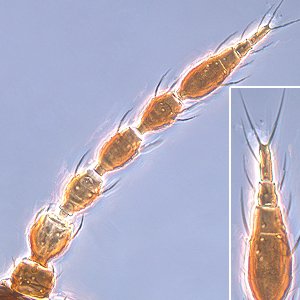Figures
Fig. 1: Antenna (inset: VI.-VIII. [IX.] antennal segment)
Fig. 2: Head dorsal
Fig. 3: Pronotum
Fig. 4: Meso- and metanotum
Fig. 5: Sternites III and IV with craspeda
Fig. 6: Tergites V and VI
Fig. 7: Tergites VIII-X
Fig. 8: Tergites IX and X
Taxonomic Information
Species:
Apterothrips apteris (Daniel, 1904)
Synonyms:
Apterothrips delamarei Bournier, 1962
Sericothrips ineptus Ahlberg, 1922
Sericothrips stanfordii Moulton, 1907
Sericothrips apteris Daniel, 1904
Common name:
None established
Present taxonomic position:
Family:Thripidae Stephens, 1829
Subfamily:Thripinae (Stephens) Karny, 1921
Genus: Apterothrips Bagnall, 1908
Species Recognition
General information about the genus Apterothrips:There are only two species known in this genus. Both species are dark brown, have well developed craspedum on the posterior margins of the tergites, the antennae have 8 segments and both species are commonly found wingless. Only one species is included in this key.
Typical character states of Apterothrips apteris:
Body color
Mainly brown
Antennae
Number of antennal segments: 8 (-9)
Segments II and III shape: more or less symmetric
Segments III & IV sensoria: emergent and simple
Base of sensorium on antennal segment VI: no more than 2 times as wide as base of nearest seta
Terminal antennal segments: rarely elongate
Head:
Head shape between compound eyes: not prolonged
Ocellar setae III on head: arising on anterior margin of, or in front of, ocellar triangle
Postocular setae I: present
Surface of head, pronotum and fore legs: without strong reticulate sculpture
Ocellar setae I in front of anterior ocellus: present
Prothorax
Number of pairs of elongate pronotal setae: 0-3
Number of pairs of elongate posteroangular pronotal setae: 0
Pronotum shape: rectangular
Mesothorax
Mesothoracic endofurca: without median spinula
Metathorax
Metanotal median setae length: longer than lateral metanotal setae - shorter than lateral metanotal setae
Metanotum: with campaniform sensilla
Metanotum major sclerite: with only one major sclerite, this is at least twice as wide as long
Metanotum median area: with no equiangular reticulation
Metanotum sculpture: without dominant sculptured triangle medially
Metathoracic endofurca: transverse, sometimes with simple median spinula
Wings
Wings: absent
Legs
Fore tibial apex: not extending around fore tarsus
Mid and hind tarsi: with two segments
Abdomen:
Abdominal pleurotergites: not covered in microtrichia
Abdominal segment X: never tubular, longitudinally incomplete ventrally in both sexes
Abdominal sternite II: with marginal setae but no discal setae
Abdominal sternite III of female: without glandular areas
Abdominal sternite VII median marginal setae: arising in front of margin
Abdominal sternites IV , V and VI: with marginal setae but no discal setae
Abdominal tergites: without curved wing-retaining setae
Abdominal tergites IV & V median setal pair: much shorter than distance between their bases
Abdominal tergites V-VII: without paired ctenidia, sometimes with irregular microtrichia
Setae on abdominal tergite X: slender
Surface of lateral thirds of abdominal tergites: without regular rows of fine microtrichia
Ctenidia on tergite VIII: not present, but groups of microtrichia
Tergite VIII posteromarginal comb of microtrichia: absent
Biology
Life history:
As with other thrips species the life cycle from egg to adult is dependent on temperature. The full cycle can take a couple of weeks to over a month and adults may live for more than one month producing several generations in one year depending on seasonal weather.
Host plants:
Erigeron glaucus (Asteraceae) (California, USA), Medicago (Fabaceae), Allium sativum (Liliaceae) and grasses (Poaceae).
Vector capacity:
None identified
Current known distribution:
Australia/New Zealand, Central and South America, North America, California
Additional notes:
Primarily found on Erigeron glaucus along the Northern coast of California, USA and on garlic in regions South of California causing leaf deformation.
Bibliography
Moritz G, Morris DC, Mound LA (2001): ThripsID - Pest thrips of the world. ACIAR and CSIRO Publishing Collingwood, Victoria, Australia, CDROM ISBN 1 86320 296 X.
Moritz G, Mound LA, Morris DC, Goldarazena A (2004): Pest thrips of the world - an identification and information system using molecular and microscopial methods. CBIT, University of Queensland,CDROM ISBN 1-86499-781-8.
Mound, LA & Kibby, G (1998): Thysanoptera: An identification
guide, Second edition.
Mound LA & Marullo, R (1996): The thrips of Central
and South America: An Introduction (Insecta: Thysanoptera). Associated
Publishers, Gainesville.
Links:
Mound, LA (2005): Thysanoptera (Thrips) of the World
- A Checklist. http://www.ento.csiro.au/thysanoptera/worldthrips.html









